I had descended without any issues and was now about 30 feet/ 9 meters underwater. In front of me was a wall of giant kelp. Golden seaweed stretched from the seafloor a couple of meters below me way up to the surface far above me.
I slowly swam into the kelp, gently pushing the swaying vertical fronds apart. I was soon lost in a forest of seaweed, with just my dive buddy beside me.
A bright orange fish swam past. I was distracted by the flash of color, when suddenly something bigger and darker dashed up to me. Right on front of my nose, looking into my mask, was a playful harbor seal.
It looked at me, then turned and darted away, almost immediately disappearing into the kelp. How cool was this?!
I was at the Californian Channel Islands, SCUBA diving near Anacapa Island.
Subscribe to daily national parks planning tips, travel inspiration and trip ideas and get instant access to the free PDF of this
Guide to Channel Islands Scuba Diving
No time to read about giant kelp diving in the Channel Islands now? Pin it for later:
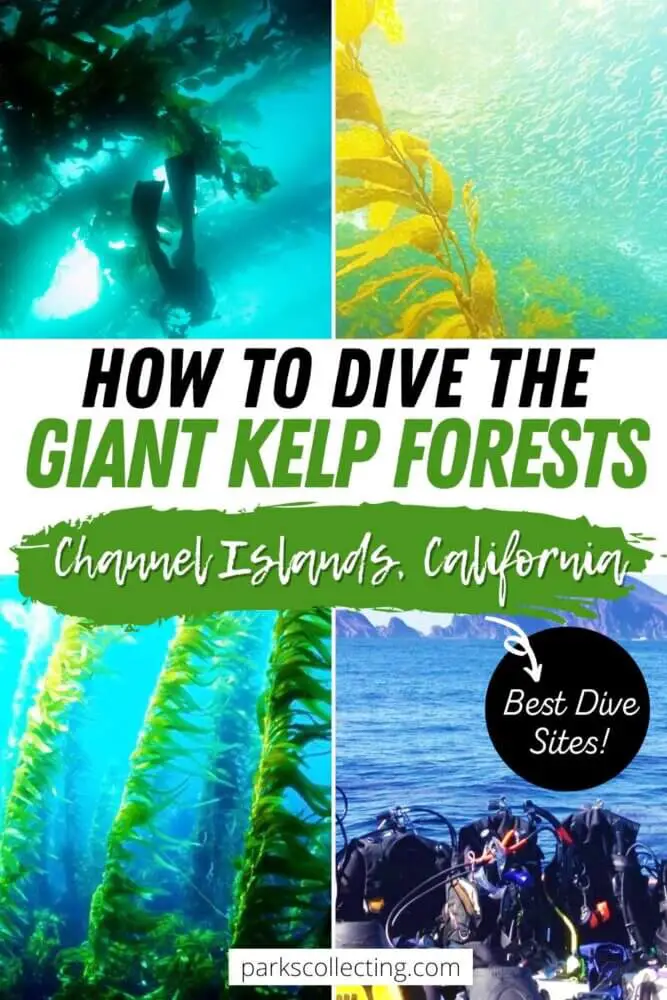
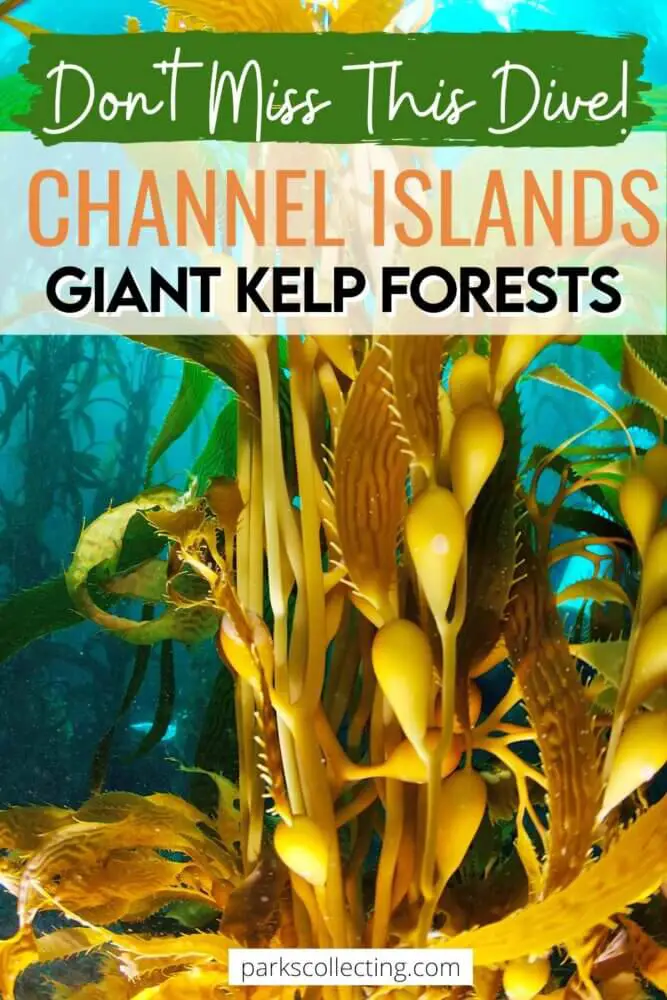
🛏️TOP HOTEL PICK: Check availability now
🚘FIND THE CHEAPEST CAR RENTAL: Search Discover Cars for the best deals
✈️FIND THE CHEAPEST FLIGHTS: Search Skyscanner for the best deals<
🧳GET TRAVEL INSURANCE: Get insured with Travelex before you go
Table of Contents
Channel Islands SCUBA diving, California
It strange to think of L.A. and diving together, but actually kelp diving in California is one of the top dive experiences in the world. I had wanted to go on a SCUBA diving trip in California ever since I’d first read about the giant kelp forests, so when we planned a trip to southern California, it was on my list of things to do.
Getting to Anacapa Island
Anacapa Island actually consists of three smaller islets, East, Middle, and West Anacapa Islands. They are located approximately 14 miles/ 22.5 km south of Ventura, California and boats usually leave from Ventura Harbor.
The boat left at 7:30 am and we were staying in central L.A., so we had headed out at 5:30 am to make sure I was there in time. Kevin is not a diver, so he drove me there – and then spent the day hanging out in L.A. before picking me again when we got back about 6:00 pm.
The Anacapa Islands are beautiful – jutting straight out of the ocean, and I was excited as we approached them. They are actually the closest of the eight Channel Islands to shore (when reached from Ventura Harbor) and it only took about 1.25 hours to get there.
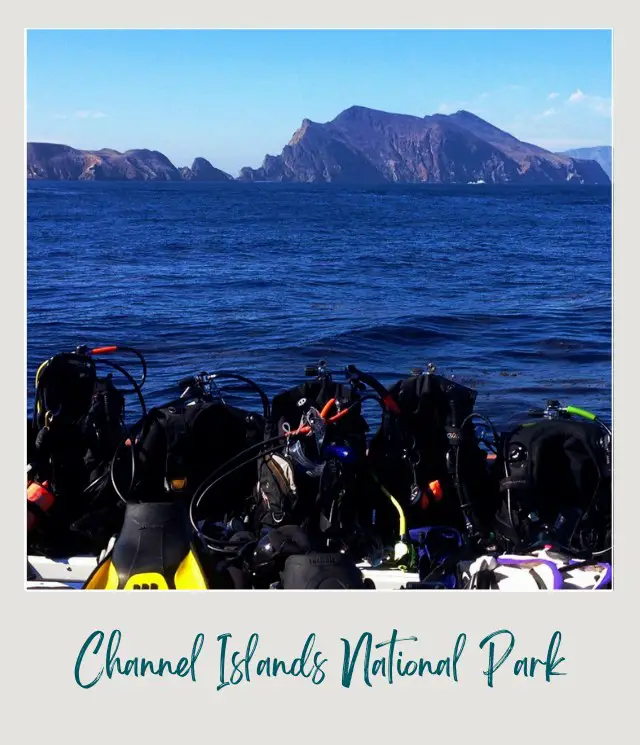
Dive 1: Canyons
This was a nice introduction to the kelp forests. Maximum depth 39 feet/ 11.8 m. We jumped in just outside a small kelp forest and swam into the kelp.
It was awesome! It’s another world, being surrounded by giant seaweed fronds, pushing them apart to make my way through them. There wasn’t much marine life other than the kelp, but I was in heaven.
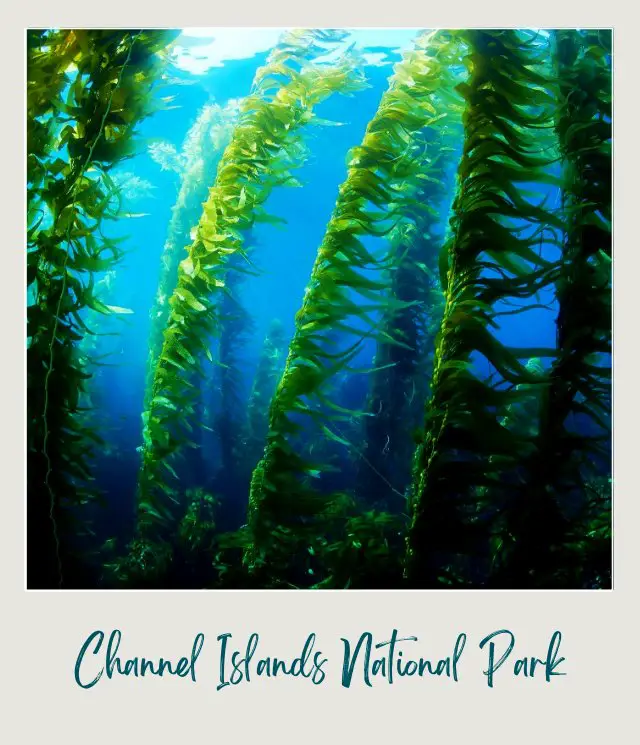
Dive 2: Cathedral Cove
This was the best of the three dives of the day. Maximum depth 38 feet/ 11.5 m. There was lots of kelp and bright garibaldi fish that this area is well known. They are really cool.
There was also plenty of other fish swimming around. There was no shortage of things to look at and enjoy. And of course, my encounter with a harbor seal (or was it a sea lion? – I’m actually not sure). It darted away quickly, but came right up to my mask and looked at me. Great fun!
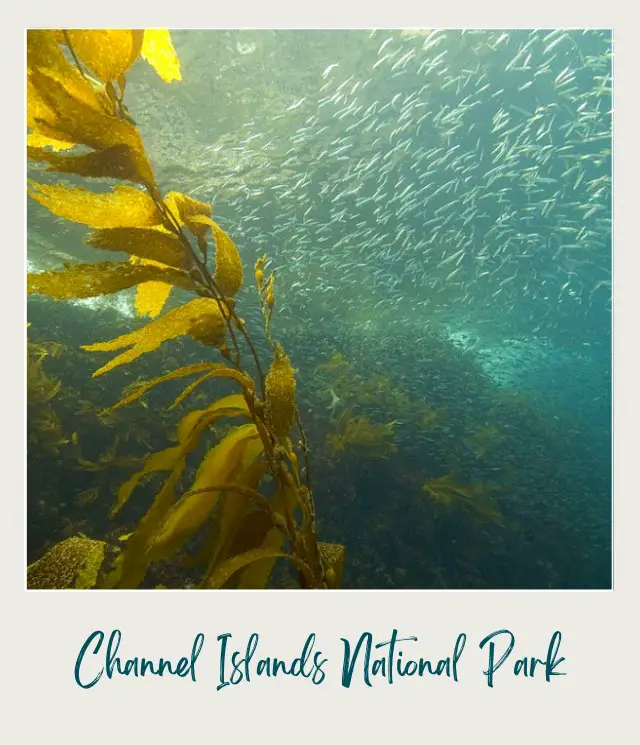
Dive 3: Winfield Scott
Another great dive to end the day. Maximum depth 36 feet/ 11 m. More kelp of course (which was the main thing I wanted to experience), but there were lots of other cool things like giant lobsters and sea cucumbers.
Of course there was lunch in between and a weary but extremely satisfied James on the way back.
The verdict: Kelp forest California diving
It was everything I had imagined! Diving through the California kelp forests was incredible. The cheeky seal (sea lion?) was an added bonus!
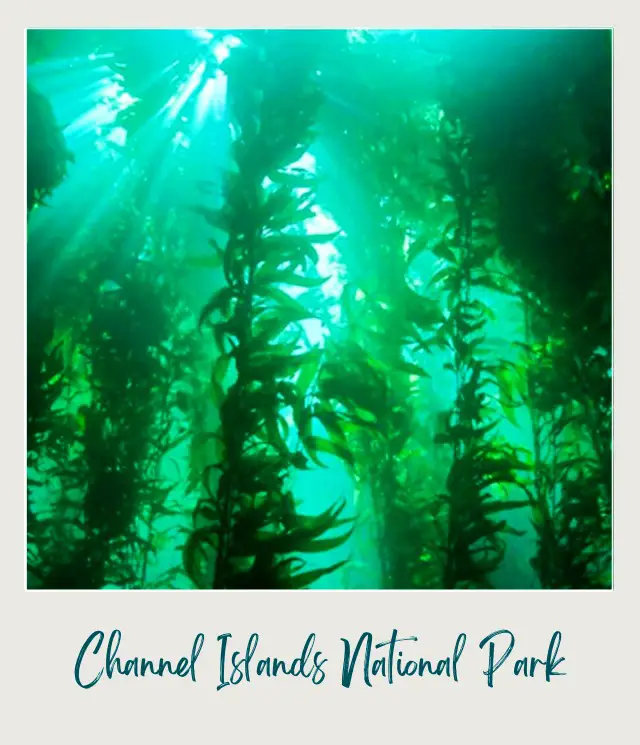
The Experience: Kelp diving, California
Diving in the giant kelp forests of California is one the world’s top diving experiences. The giant seaweed forests are around the Channel Islands.
Subscribe to monthly updates with tips for planning, travel inspiration and trip ideas and get instant access to the free PDF of this
Guide to Channel Islands Scuba Diving
The Channel Islands and Channel Islands National Park
The Channel Islands are eight islands off the coast of California around L.A. The five northern Channel Islands (San Miguel, Santa Rosa, Santa Cruz, Anacapa, and Santa Barbara Islands) make up the Channel Islands National Park.
The other three (the southern Channel Islands) are Santa Catalina, San Clemente and San Nicolas Islands. Seven of the islands are nature reserves. Santa Catalina (usually just called Catalina Island) is the only one of the eight islands with human settlements. There are two towns – Avalon and Two Harbors.
The Channel Islands’ kelp forests are the area’s main attraction. Probably the two most famous islands are Catalina Island and Anacapa Island.
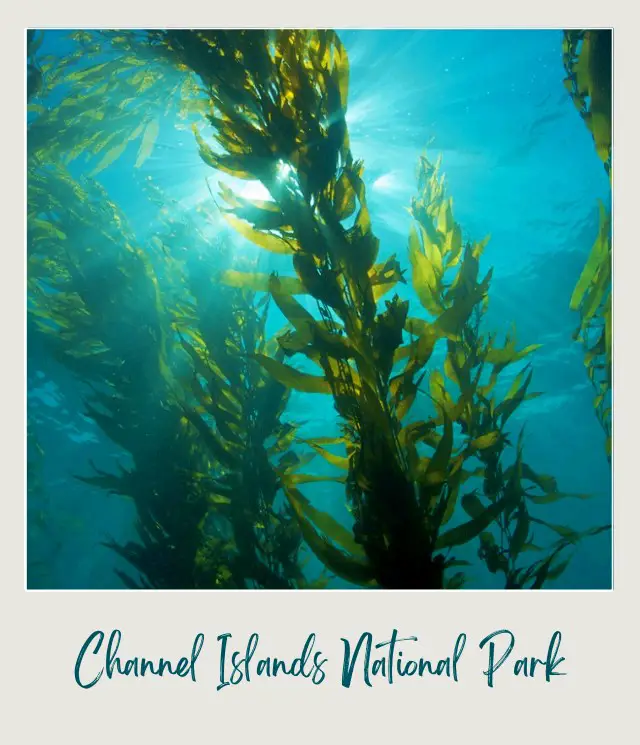
Where is best to dive the Channel Islands?
There are a few options to SCUBA the Channel Islands. The main options (including how to get to the Channel Islands) are:
1. Diving straight from Santa Catalina Island
Catalina Island SCUBA diving can be done from the island or from the mainland.
Getting to Catalina Island
There are two towns on the island and both have ferries – Avalon and Two Harbors. Ferries leave from 3 different ports, all south of LA. Click here for the schedule of the Catalina Express ferry to/ from Catalina Island.
Catalina SCUBA diving is possible from both towns.
Dives from Avalon, Catalina
In Avalon, there is shore diving from Casino Point at Casino Point Underwater Park/ Avalon Dive Park. One of the main Catalina Island diving operators in Avalon is Catalina Divers Supply. They have shore dives and boat dives. Shore dives are at the Avalon Dive Park daily at 8:00am, 10:00am, 12:00pm, and 2:00pm (2 hours each dive) The price of $115 per person or $135 for a private experience includes all equipment. Their boat dives are Fridays, Saturdays & Sundays 9:00 a.m. to 2:00 p.m. Prices for boat dives from Catalina is $107 for 2 dives (gear NOT included) and $85 for snorkelers (includes gear).
Dives from Two Harbors, Catalina
You can rent dive gear at Two Harbors and do shore diving by yourself (with a buddy, of course).
Other things to do on Catalina Island
There are actually lots of fun things to do on Catalina in addition to diving, including a zip line, a food tour and a bison tour.
➡️ Check out all of the fun Catalina experiences here.
2. Diving Catalina Island as a day trip from LA
Boats for the Catalina Island kelp forest usually leave from San Pedro port south of LA.
There are several operators. Eco Dive Center has Catalina Island Diving trips go most weekends from San Pedro. It costs $135 for 3 dives (gear not included).
➡️ You can check out their trip schedule here.
3. Diving Anacapa Islands and/ or Santa Cruz Island
Boats for Anacapa Island SCUBA diving and Santa Cruz usually leave from Ventura Harbor north of LA.
Eco Dive Center also has Anacapa SCUBA diving trips (often alternating weekends with their Catalina trips) from Ventura Harbor. It costs $140 for 3 dives (gear not included, but can be rented at their dive shop) for Anacapa and/ or Santa Cruz.
➡️You can check out their trip schedule here. This is the trip I did and I was extremely happy with their service.
Blue Holic SCUBA also has a monthly trip to Anacapa/ Santa Cruz, also leaving from Ventura Harbor. Prices were not available on their website.
4. Diving San Miguel Island and/or Santa Rosa Island
The boats for the most northern Channel Islands usually leave from Santa Barbara.
Blue Holic SCUBA also has one or two trips/ month to San Miguel / Santa Rosa Island. The 3-dive trip leaves at 3:00am from Santa Barbara. You need to board before midnight and sleep onboard. Prices were not available on their website.
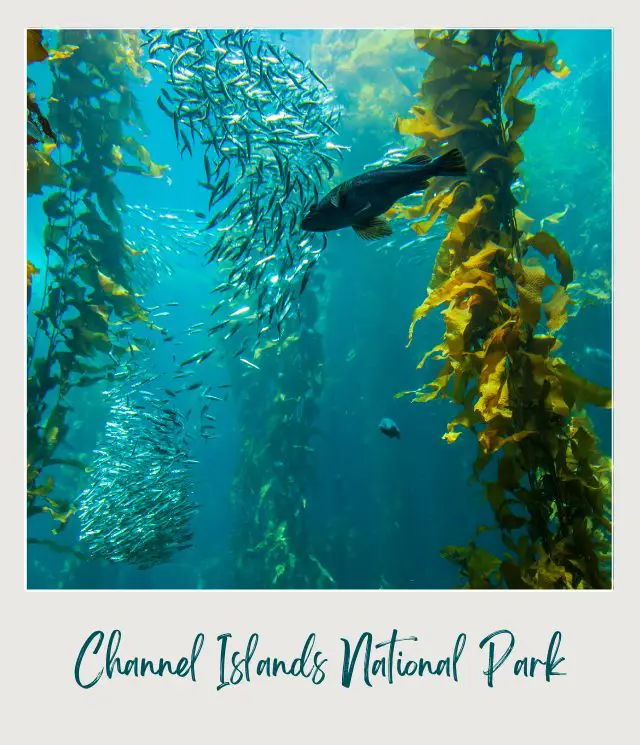
The best choice for Channel Islands diving
Of course, the best choice is different for everyone. However, for me, Eco Dive Center was the best for several reasons. I did this dive as part of a bigger trip around California, and this dive was a day trip, not the main focus of the vacation. And my husband doesn’t dive, so I wanted to limit this to one day.
✅ They have a shop in Culver City. I needed to rent some of my equipment, so had to go there the day before the dive. The fact that their dive shop was central, rather than out by the port, made this more convenient.
✅ I could do it one day. The trips from Santa Barbra and from Catalina Island take up more than a day.
I did the trip to Anacapa rather than Catalina only because this was the trip running on the day I had available. I think either of them would be equally great.
Eco Dive Center was well organized and the equipment I rented was in good working condition.
If you specially want to go SCUBA diving in Channel Islands National Park, then options 3 and 4 are for you, because Catalina is outside the national park. However, diving Channel Islands National Park isn’t necessarily any better – the California giant kelp forest extends throughout all of the Channel Islands and is common all around Catalina.
If you are not a diver, but still want to experience the California kelp forest, then Channel Islands snorkeling is also an option. Most dive centers also have prices (and equipment) for snorkelers.
Best time of year for Channel Islands SCUBA diving
So, when is the best time to dive the Channel Islands?
Visibility of Channel Islands for diving
Channel Islands diving (and snorkeling) is possible all year round. However, the best underwater visibility in the Channel Islands is between July and January and sometimes into February. The best visibility is September to November. I dived in November and visibility was good. The southern Channel Islands have the clearest water, with visibility up to 80 feet (24 meters) of visibility. April to June there are often plankton blooms and green water, with visibility of about 20 feet/ 6 meters.
Channel Islands water temperature
Summer is obviously the warmest and from mid-July to late October, the surface water temperature is over 70°F / 21°C. The Channel Islands are coldest between February and late June (around 50°F / 10°C). The southern Channel Islands Catalina and San Clemente are warmest, and San Miguel up north can be below 50°F / 10°C.
The major dive sites in the Channel Islands, California
Best dive sites Anacapa Island
🤿 * Canyons – kelp
🤿 Cat Rock – kelp, brittle stars
🤿 * Cathedral Cove – Giant Kelp forest, lots of fish, garibaldis and a sea lion rookery
🤿 Channels – Harbor Seals
🤿 Coral Reef – millions of brittle stars making a brittle star carpet (60-80f feet/ 18-25 meters). Currents can be strong.
🤿 Landings cove – a large underwater arch you can swim though, lots of fish, nudibranchs
🤿 Lighthouse
🤿 Pelican reserve – nudibranchs, juvenile fish and uncommon critters. Only open in November
🤿 Portuguese Rock
🤿 Rat Rock – good overall diving
🤿 Underwater Island / Island Reef – near Channels, pinnacle 20 feet/ 6 meters, brittle stars, rockfish, black-eyed gobies, baby sheepshead, lingcod, and sea fans
🤿 * Winfield Scott – kelp, giant lobsters, sea cucumbers
* The sites I dived
Best dive sites Santa Cruz Island
The diving is better in the west of the island
🤿 Bowen Point – kelp forests, torpedo rays
🤿 Flame Reef – nudibranchs, small fish
🤿 Gull Island – lots of kelp, large fish, sea lions, harbor seals
🤿 Painted Cave area – Walls, sea lions, lots of fish
🤿 Potato Rock – a small pinnacle with nudibranchs
🤿 West end Pinnacles – pinnacles, sand channels, nudibranchs
Best dive sites Santa Rosa Island
There is a lot of lobster fishing here
🤿 Bee Rock
🤿 East end pinnacles – there are several underwater pinnacles around 50 feet/ 15 meters deep
Best dive sites San Miguel Island
🤿 Judith rock pinnacle – pinnacle about 55-60 feet/ 16.5-18 meters deep. Heavy currents are common.🤿 Rainbarrel – large kelp forest, abalones
🤿 Richardson Rock – good deep diving, but often has a strong current
🤿 Skyscraper & Boomerang – pinnacle about 55-60 feet/ 16.5-18 meters deep. Good deep diving, but often has a strong current
🤿 Wilson Rock -good deep diving, but often has a strong current
🤿 Wyckoff ledge – Wolf eels, mosshead warbonnets and nudibranchs
Best dive sites San Clemente Island
The Navy often closes most of the island, so it is often not open for diving
🤿 Castle Rock – kelp forest, shallow caves
🤿 Little Flower – large reef, soupfin sharks
🤿 Nine Fathoms/ Arch Rock – 60 feet/ 18 meters deep, purple hydrocoral
🤿 Pyramid Cove – kelp, sea fans
Best dive sites Santa Barbara Island
The best place in Southern California to see sea lions because of its sea lion rookery
🤿 Sea Lion Rookery – shallow, sheltered, lots of sea lions in clear water
🤿 Archway – lots of fish, purple hydrocoral
🤿 Black Cavern – caves and caverns, deep
🤿 Sutil – kelp
🤿 Brittle Star Reef – kelp, millions of brittle stars making a brittle star carpet (60-75 feet/ 18-23 meters)
Best dive sites San Nicolas Island
San Nicolas Island is very exposed, and the Navy closes most of it off, so it is not common for dive boats to go here
🤿 Begg Rock – lots of fish, very deep and exposed
Best dive sites Catalina Island
There is no shortage of things to see on Catalina Island dives. Giant kelp forests are all around Catalina Island. Bat rays and angel sharks are often found in the sand near the kelp; octopi and moray eels can often be found in crevices; horn sharks & leopard sharks are not uncommon; sea fans & anemones are common; harbor seals are also common in shallow water in the kelp, and bright orange garibaldi, blue-banded gobies, and sheepshead are all around, as are nudibranchs.
🤿 Bird Rock – kelp, small walls
🤿 Blue Cavern Point – wall with some sea fans, caves and caverns. A drift dive
🤿 Eagle Rock – sea fans
🤿 Farnsworth Banks – purple hydrocoral, lots of fish, and torpedo rays. Advanced divers only
🤿 Italian gardens – kelp, giant black sea bass July to October 40-70 feet (12-21 meters) deep
🤿 Long point – tall kelp, wall with sea fans 60-100 feet (18-33.5 meters) deep
🤿 Rock quarry – kelp, scythe butterfly fish, angel sharks
🤿 Ship Rock – kelp, lots of fish, angel sharks, nudibranchs
🤿 Two Harbors area (Sea Fan Grotto, Blue Cavern, Lion’s Head, Bird Rock and Eagle Reef) – giant kelp forests, lots of fish
🤿 West end cove – jack mackerel, harbor seals, yellowtail, nudibranchs. Currents can be strong.
Map of the Channel Islands
I had no idea where the ports were and where they were in relation to downtown LA, and to the different Channel Islands when I first started planning my trip. It is really helpful to know this though, when deciding what option to choose. So, I made this map:
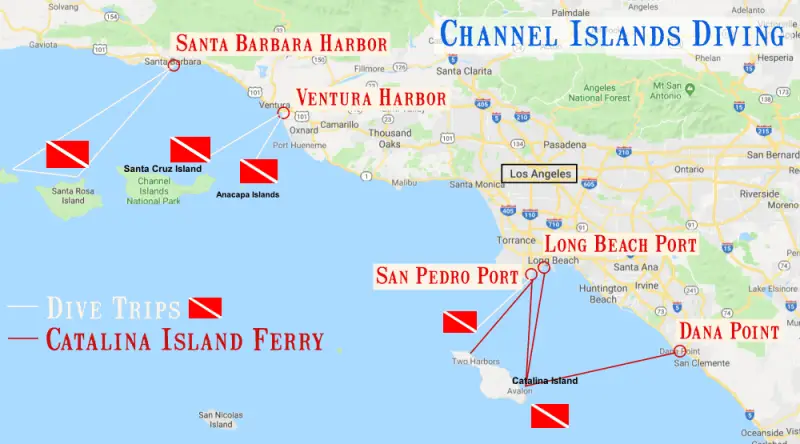
Dive gear for diving the Channel Islands
I like to travel light without a whole bag of dive gear, because this was just on part of a bigger trip. The basic essentials for this trip are:
1. Mask
It’s possible to rent mask and fins, but they typically suck, so I try to bring my own with me if at all possible. I love the Aqualung Mask. It fits great – I have a high bridge over my nose and used to get headaches from ill-fitting masks. The Aqualung Mask did away with this, so I LOVE it.
➡️ If you are looking for a new mask, buy the Aqualung Mask here.
2. Fins
I prefer open-heeled fins, as they are easier to get on and off. The booties that you have to wear also keep your feet warm. I like Tusa Imprex fins.
➡️ If you need new fins, buy the Tusa Imprex fins here.
3. Booties
You need booties in cold water, of course, and 5mm is best at these temperatures. I was very comfortable with my Scubapro booties.
➡️ Buy the Scuba Pro (unisex, 5mm) booties here.
4. Knife
I actually got a knife specifically for this dive. Of course, it’s always a good idea to take a knife with you, but it is essential when diving in kelp because it is possible for the kelp to get caught around your tank and/ or BCD. You should NEVER dive in kelp without you and your buddy having a knife.
➡️ Buy the Tusa Imprex knife here.
5. Dive Flashlight
I first got a dive flashlight when I started doing night dives, but now I always carry it with me. There will often be a crevice or hole to explore. I actually take my dive flashlight with when I travel even when I’m not planning on diving – you never know when a waterproof flashlight will come in handy. I’ve used it for hiking, camping, and caving. I like the BigBlue dive torch – it’s small but fairly powerful.\
➡️ Buy the BigBlue dive flashlight here.
I rented wetsuit, hood, gloves, BCD and dive computer from the dive shop, but of course, if you have gear and want to bring it, your own gear is always most comfortable.
Travel Insurance
My aim is to not only inspire you to have amazing experiences when you travel, but to also give you the practical information and resources you need to have them. In addition to accommodation, planning and flights, you should always have travel insurance, just in case.
➡️ A great insurance option is Travelex. It has coverage for all you’ll need. You can choose the best travel insurance plan for your trip here or get a quote right now:
Have a great dive!
Additional Planning Resources for Channel Islands National Park
⭐ Planning A Trip to Channel Islands National Park: 7 Mistakes to Avoid
⭐ 10 Tips for Visiting Channel Islands National Park
⭐ How to Get to Channel Islands National Park
⭐ Closest Airport to Channel Islands National Park
⭐ The Airports Near Channel Islands National Park
⭐ Best Time To Visit Channel Islands National Park
⭐ Visiting Channel Islands National Park: What To Expect Throughout the Year
⭐ Fun Facts About Channel Islands National Park
Do you have any dive stories to share ? I’d love to hear them. Join my private Facebook group National Parks Collectors and comment and let me know.
Subscribe to daily national parks planning tips, travel inspiration and trip ideas and get instant access to the free PDF of this
Guide to Channel Islands Scuba Diving
If you liked this article, Pin It to your Diving board for later!


💡 Are you just starting to think about taking a national parks trip? Get Inspiration
‼️ Are you looking for helpful tips for visiting US national parks? Read articles that share useful tips on a range of national-park related issues
💻 Are you starting to plan a trip to Channel Islands National Park? Read my Guide to Channel Islands National Park
💲 Are you ready to book your trip? Use these Planning and Booking Resources
📖 Do you want to read a book about US national parks? Check out my Recommended Reading Lists
About the Author
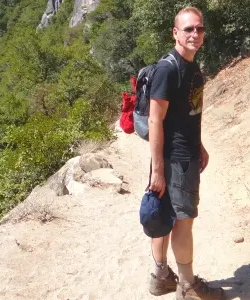
James Ian is a national park, camping and hiking expert.
He has dedicated his life to travel, visiting more than 80 countries, all 7 continents and most of the national parks in the United States. With over 35 years experience in the travel industry, James has worked on cruise ships, at resorts and hotels, and as a travel planner who’s helped hundreds of people plan successful trips to US national parks.
Based on his experience visiting our national parks multiple times, in-depth research and expertise as a travel planner, James has published detailed itineraries for many of the major national parks in the US. These itineraries, as well as in-depth park guides, and other resources will help you have your own incredible trip to US national parks without stress and hassle.
As a national park expert, James has contributed to many publications, including USA Today, Newsweek, Time Business News, Savoteur, Best Trip, and Wired.
I’m a member of the Amazon Services LLC Associates Program. As an Amazon Associate I earn from qualifying purchases.
